We arrived in Cairo on a lovely clear evening, and then awoke to...
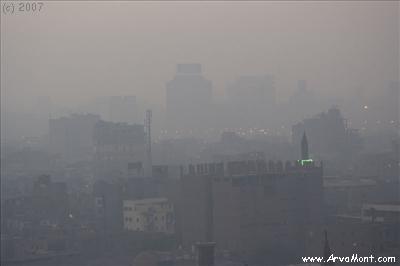
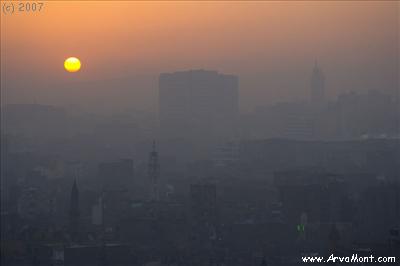 smog!
smog!
Cairo is a big city
with a small town attitude. There are people on the streets at all hours
and the traffic barely moves. When the call to prayer begins, you can hear
it from multiple mosques all at once. It can be quite loud and
discordant in a rather interesting way.
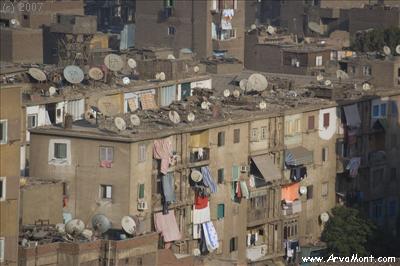
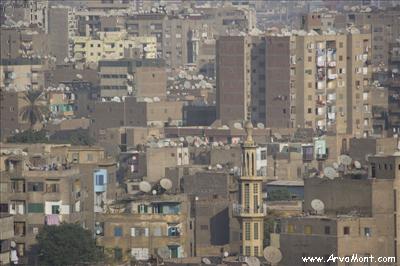
 The view from our windows was captivating.
The view from our windows was captivating.
Fresh produce was everywhere


We took a trip to the Egyptian
Museum, where photography is forbidden inside. It is filled to the brim
with ancient treasures, they just haven't enough space for all of it! We
did snap a few photos outside the museum...
Read more.
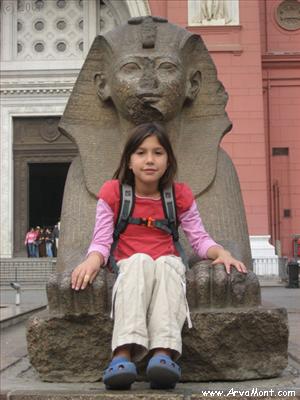
We didn't photograph the heavily armed Tourist and Antiquities police (it's
apparently illegal), which are
everywhere. While they are there for our safety, it can make one quite uncomfortable - is
it really so dangerous for
tourists here? Some of these guys, however, are happy to assist you in
"bending" the
rules or even having a photo with them - it just takes a little baksheesh.
Saqqara
We decided it was time to step out and see some sights. The hotel
offered
organized tours for organized tour prices. We toyed with the idea, but we
decided to just get in a taxi and see what we would see. This approach
worked out well for us! We hired a taxi on the street for the day, which
was
amazingly affordable, and drove to Saqqara and then to Giza.
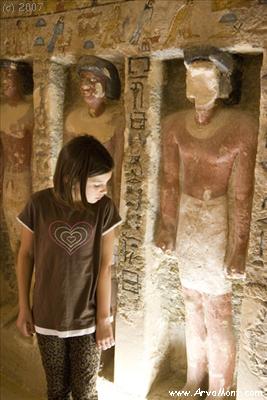
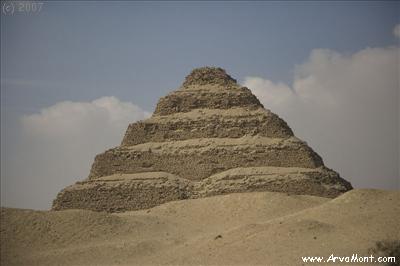
The first pyramid - built by King Zoser
in Saqqara. It is called the Stepped Pyramid, built around 2650 BC.
Intrigued?
Read
more.
Also in Saqqara are a series of
tombs of ordinary people. We toured a couple. These were even more
impressive than the Stepped Pyramid! In the tombs of ordinary folks were
depicted scenes from their lives. It is like spying on someone who lived
4500 year ago! The first was a tomb of brothers who were manicurists to
the king! One died young, so his side of the tomb is unfinished. The
second tomb was of a butcher. Also fascinating. We were very
pleasantly surprised with all that we saw and learned in Saqqara.
Going to see these pyramids was very high on my list of things to do this
year, though I was strangely disappointed by our visit. Yannis was
inspired photographically, but even he experienced a feeling of disappointment
caused by all the harassment of the hawkers all around these wonderful pyramids.
Read about my impressions.
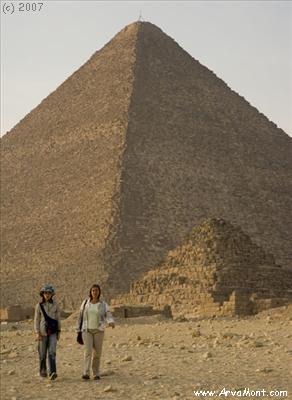
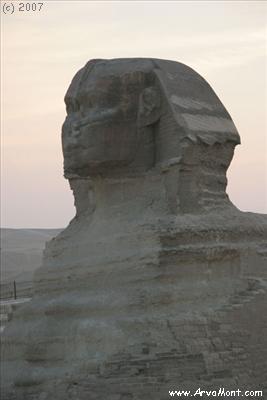
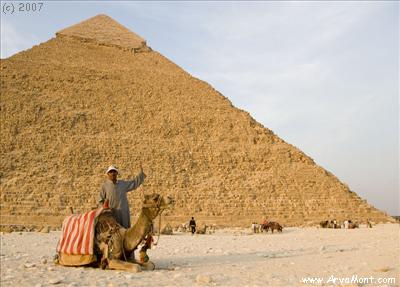 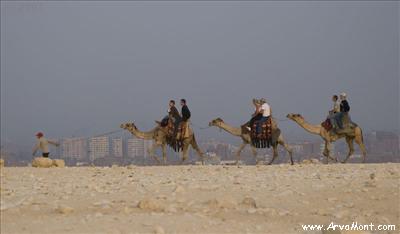
A traditional photo (courtesy of some
baksheesh).
The pyramids butt right up to Cairo - a camel train with the city as a backdrop.
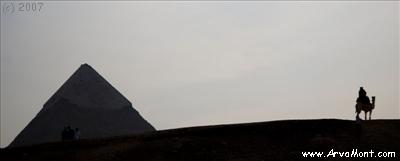
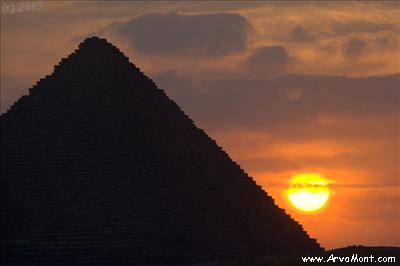

We stayed for the Sound and Light Show, which was as cheesy as we had
anticipated! The ride home was amazing. Our taxi driver squeezed
through a few spaces that were so tight he was brushing up against people as he
cruised by!
From Cairo we flew to Nairobi via Khartoum and then on to Kilimanjaro, where
we commenced our safari. Unfortunately, we
missed our connection in Nairobi and ended up spending the day at the Nairobi airport
waiting for the next flight (only 2 flights a day - morning and evening). Of course we had to stand in line for hours to
get this all arranged.
After our two weeks in the bush our plan was to return to Cairo via Nairobi
and Khartoum. Unfortunately, Kenya Air had other plans. This time
they bumped us in Nairobi even though we were on time and had confirmed seats. No problem - you can take the next flight -
it will arrive in Cairo tomorrow night. What?! Sure, they would put us up in a hotel, so what was our
problem? (Of course they would not pay for the Kenyan visas! That
would have cost us $80.) The main issue was that we had a cruise booked starting at noon tomorrow in Luxor. They finally agreed to rebook us, and found us flights through Addis Ababa and Khartoum, although only Tasha was
confirmed all the way! The rest of us would be stand-by. And we
would travel through the middle of the night with long layovers in both Addis
and Khartoum. Oh, this sounded horrible, but that was the result of 2
hours of waiting with Kenya Air's transit desk. We retired to the lounge and started brain storming.
Yannis found a better connection through Dubai. Only one stop over,
still in the middle of the night, but we would arrive in Cairo much earlier at
6 a.m, and possibly still make it to Luxor by noon to attend our ship's tour of Luxor. So we waited in the Nairobi airport all day, again, then flew to
Dubai. The Dubai airport may be the best place in the world to spend the
early hours of the morning, if you have to be up and spending them somewhere!
Unfortunately, we could not get a flight out of Cairo to Luxor until 5 p.m., so
we ended up spending the day in Cairo near the airport, and
missing the cruise's group tour of Luxor and Karnak Temples. Our tour
operator's local guys took the initiative and organized a private night time tour for us of Luxor Temple and a
private before-the-crack-of-dawn tour of Karnak Temple, the Valley of the Kings, and the Temple
of Hatshepsut all before the boat sailed! (Many thanks to the various
Ahmeds from Travel Plus in Giza - you guys were wonderful!)
Luxor was the ancient capital of
Upper Egypt known as Thebes, and thus has many ancient sites in close proximity.
Luxor Temple
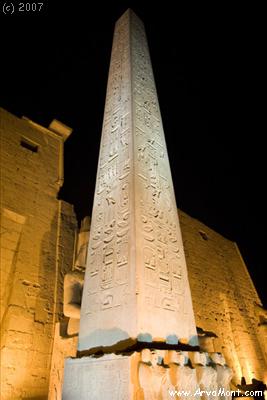
The second obelisk
guarding the doors of this temple was given as a gift to the French in 1819, and
stands outside Place de la Concorde in Paris.
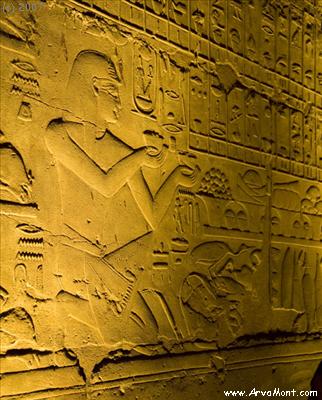
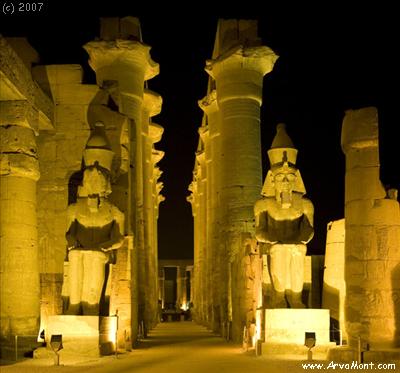
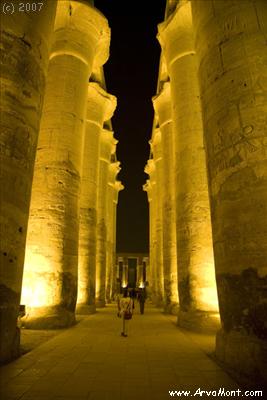
By the time we reached the Temple we had been traveling for 38 hours and had
maybe 4 hours of sleep.
Our pour tour guide (Ahmed)tried his hardest to engage us, but after the initial
excitement of seeing this magnificent temple, we were all fading fast, which is
too bad, because some of the stories are just amazing! This temple was
begun by Amenhotep III around 1400 BC, but not completed by his son, as was the
tradition. His son, Amenhotep IV was also know as Akhenaten, and he became
a monotheist, thus saw no use in a temple dedicated to the Thebian gods Amun,
Mut, his wife and the mistress of the heavens, and their son, Khonsu. The
temple was worked on by Tutenkamen and Horemheb and completed by the great
builder pharoah, Ramses II around 1250 BC.
We enjoyed learning about the various gods of Egypt, and the forms that they
favored. Learning about the movement of the sun, including being pushed
through the earth at night by the scarab beetle, was interesting. We also
learned that the early Egyptians used baboons to tell time. Apparently,
they urinate hourly, and this was a way to measure the passage of time. I
have always wondered why we have 24 hours in a day, hum...
During the early Roman period, when Coptic Christians were not permitted to
build their own churches, they took over many of the ancient temples for use as
churches. There is a section of this temple that was clearly thusly used!
There is also a mosque built on this site.
The columns in this temple and many others are uniquely Egyptian in their
layout. We all learned about ionic, doric and Corinthian columns in school
- but I never learned about the lotus and the papyrus columns.
Karnak Temple
Karnak Temple complex is large! In its day it was connected to the
Luxor Temple by the Avenue of Ram-headed Sphinxes and by a canal. It is
dedicated to the same three Thebian gods, and was built over an even longer
period - 1300 years!

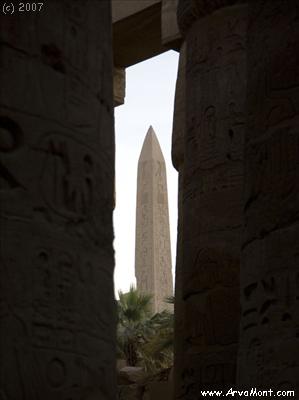
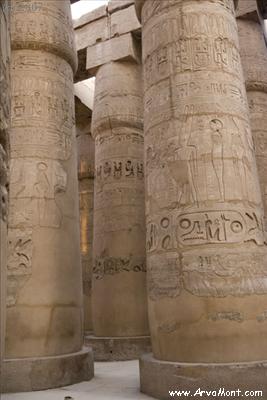
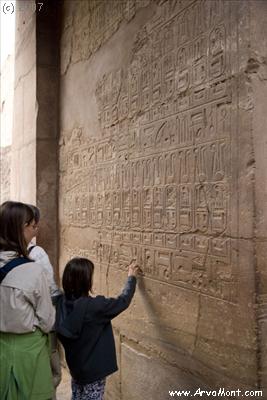
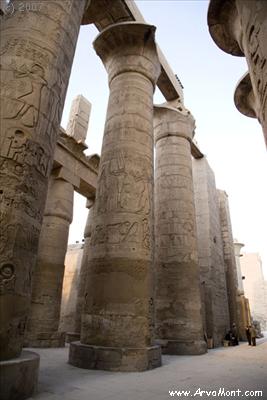
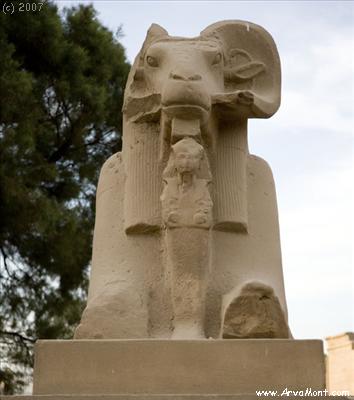
The sheer number of columns and
walls still standing in amazing. Of course, the policy of the Egyptians is
that everything should be maintained as it was found. Thus, if a wall was
standing when a temple was uncovered from the sands, then that wall will
continue standing, even if it requires re-enforcement and plaster fill ins.
Every wall and every column is
covered head to foot with pictures of pharaohs and gods engaged in important
usually symbolic activity and then surrounded by hieroglyphs. It is clear
why people wanted so badly to be able to read hieroglyphs. They are
everywhere.
The Valley of the Kings

The Valley of the Kings is where
many pharaohs were buried. There was a belief that burial should be on the
west side of the Nile - the side of the setting sun. It is thought that
they chose this valley because of the natural pyramid on the top of the tallest
hill. A pyramid would help their spirits escape the tomb.

 Of course there is no photography inside the tombs...
Of course there is no photography inside the tombs...
The Temple of Hatchepsut
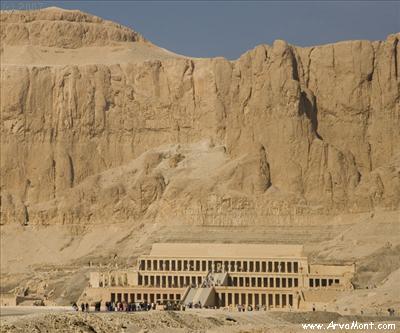
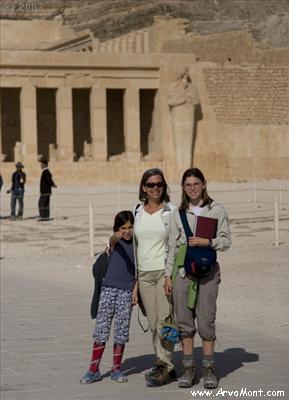 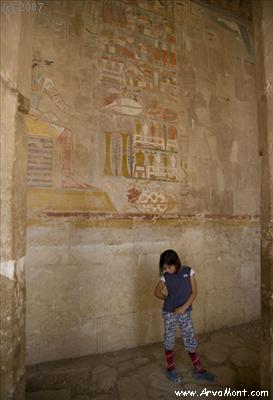
Apparently the Pharoah Hatchepsut
was an interesting character. She decided to become the pharaoh.
Since pharaohs were always men, she decided to become a man. She had
herself depicted in her statues and carvings as a man, including the traditional
pharaohic beard.
Along the Nile
The view along the Nile is captivating. There is a swath of green with
trees and grass along the river and then nothing but dry desert, though some of that
desert is quite mountainous!

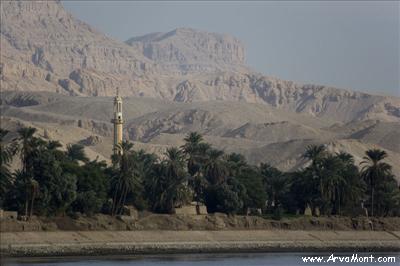
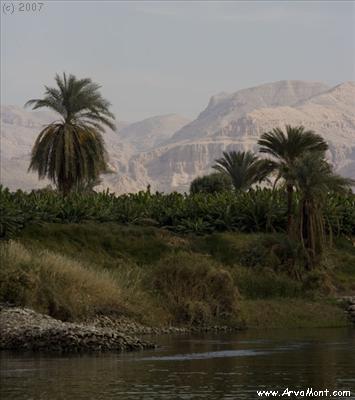 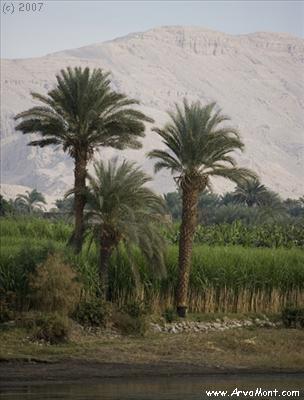 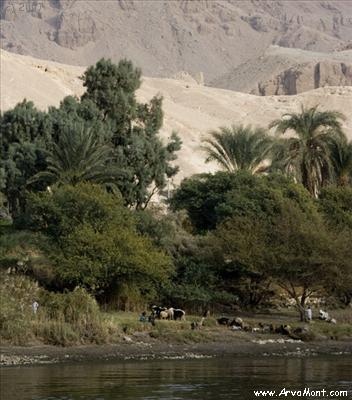

 Anika enjoying herself at a leisurely dinner.
Anika enjoying herself at a leisurely dinner.
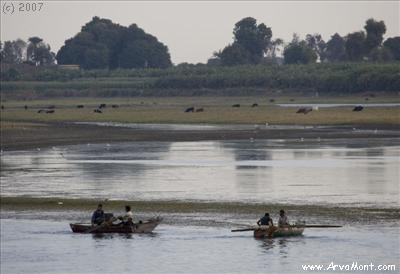 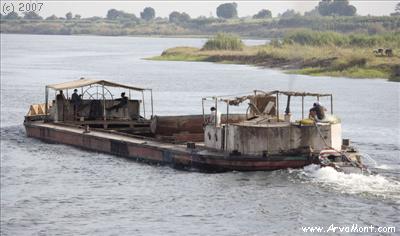
 Everyone's favorite, Anika. On her next hot chocolate, the bartender
professed his undying love for her.
Everyone's favorite, Anika. On her next hot chocolate, the bartender
professed his undying love for her.
 
Early morning along the Nile.
At the Esna Locks
It takes hours to get through the locks of Esna. There are many boats
and they all must queue. The Egyptians seem to be born hawkers, and this is
just another opportunity to sell sell sell! Welcome to the Esna
Locks Floating Market!
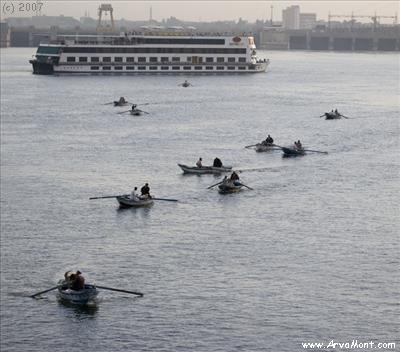 Here
they all come. Some attached themselves to our boat while we were still
cruising (giving them an early advantage), but most just rowed up once we
were stopped. You first notice them by their shouts of "Ola!" and
"Hello" - trying to get someone's attention. Here
they all come. Some attached themselves to our boat while we were still
cruising (giving them an early advantage), but most just rowed up once we
were stopped. You first notice them by their shouts of "Ola!" and
"Hello" - trying to get someone's attention.
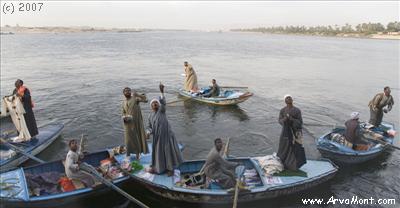
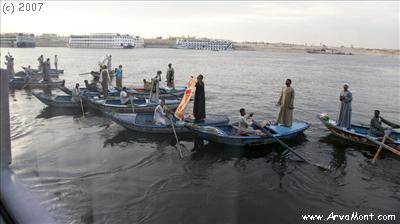
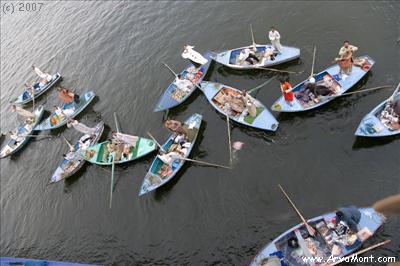
So how does it work? The
salesmen have their goods carefully wrapped in plastic bags, along with a
receipt in an envelope to indicate the price of the article. These
articles could be blouses or full length galabia with embroidery, or T-shirts or
table clothes. Any soft goods, really. They row up to the boat, and toss
their goods up on to the deck, which is 2 or 3 stories up! Someone on the
deck
looks at them and either puts money in the envelop in the bag and tosses it
back, or just tosses the whole bag back. The more adventurous try to negotiate
over the side of the ship.
This may seem straightforward, but
how do you know who tossed a certain bag up? As you can see there are many
salesmen, on both sides of the boat. And who do you throw a bag back to?
What happens to the bags that land in the water or in the wrong boat? What
about the bag that landed up on the deck in the swimming pool? We're sure
they have a system in place, but we didn't have a closer look.

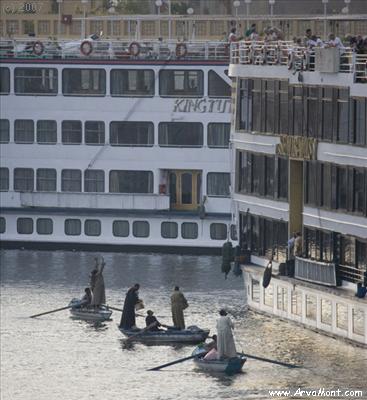
Edfu and the Temple of Horus
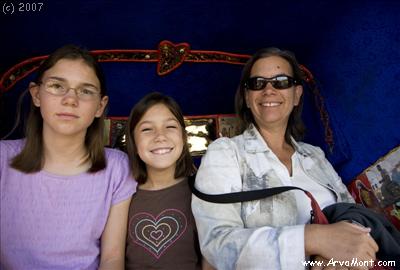 Here
we are in our horse drawn carriage on the way to the temple. Our
driver raced through the streets shouting "Ferrari!" Here
we are in our horse drawn carriage on the way to the temple. Our
driver raced through the streets shouting "Ferrari!"

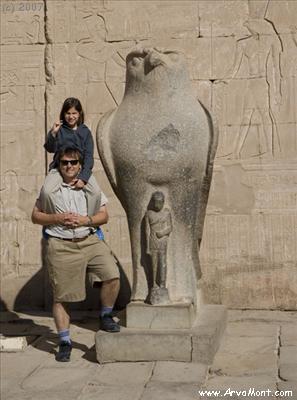
The Edfu Temple is a very complete,
but then again, it was built during the rule of the Ptolomies beginning in 237
BC and as such is much younger than the temples we had seen thus far. It
also remained safely buried until 1903. It was built to honor the sky god Horus, son of Isis, who battled and defeated his evil uncle, Set.
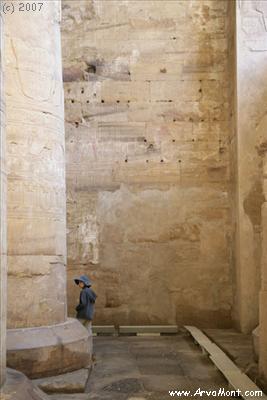
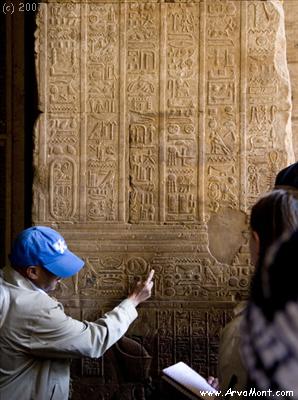
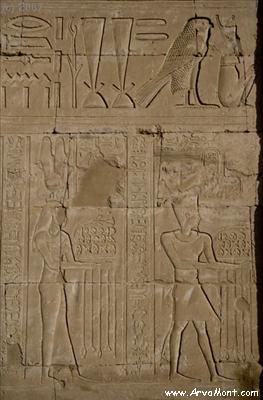 

Kom Ombo and the Temple of Sobek and Horus
This is a temple dedicate to two gods, which is apparently quite unusual.
Sobek is the crocodile god and Kom Ombo was quite a crocodile haven before the
Aswan dam was built. Horus is the god responsible for medical treatment.




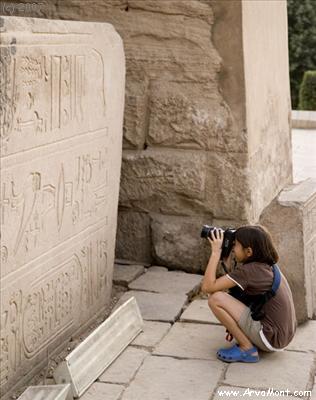
Aswan
The Unfinished Obelisk

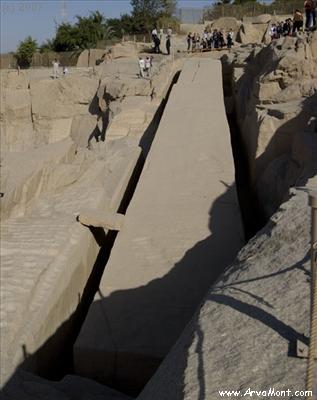 How did they cut those huge obelisks out of granite?
How did they cut those huge obelisks out of granite?
Well, here you can see one that
they abandoned. It is assumed that this obelisk, which was 3/4 cut was
abandoned because it cracked. (I don't understand why it wasn't used for
something else.) They cut these by drilling lots of holes, filling them
with cedar and then soaking the cedar so that it expands, thus cracking the
granite. Wow.
The Temple of Philae
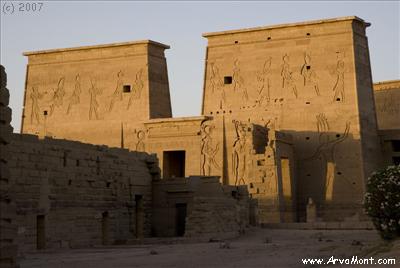

This is one of several ancient site
that were moved out of the waters of Lake Nasser after the building of the Aswan
Dam. This one sits on an island just above the low dam.

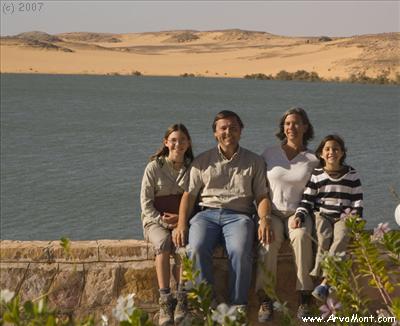
This is where Ramses II, the great builder pharaoh, "built" a temple to himself
and one to his favorite wife, Nefertari. "Built" is not, strictly speaking,
the correct verb - these temples were carved out of the side of a mountain.
He had Nefertari's temple built first, they say as practice on this new
technique! It is
also the only temple built for a woman (since Hatchepsut's Temple was built for the
male pharaoh she became.) In order to justify this, he had her declared a
goddess. Inside the temple you can see her depicted as such, carrying the
key to life. He had 50 wives and 150 children, I wonder why he chose her?
He was egotistical to the nth degree! On the outside of her temple, there are six
colossal statues, 4 of Ramses II and two of Nefertari. (He is the same
pharaoh who had the cartouches of other pharaoh's etched out and then had his
own name carved deeply on top of them.)
Temple of Nefertari
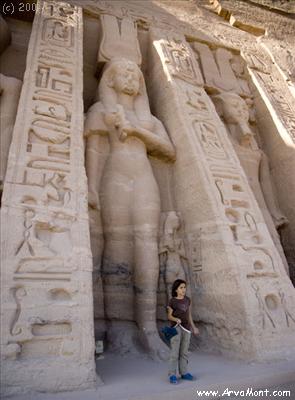

Mid-day lighting
Morning lighting (Yannis went back the next morning @ sunrise)
Temple of Ramses II
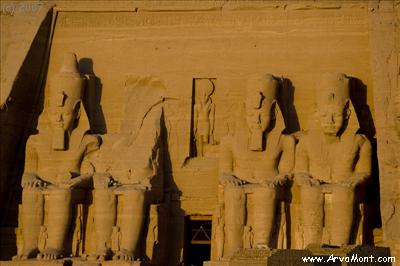
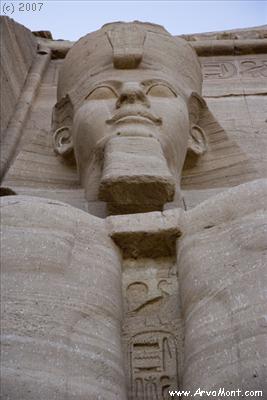
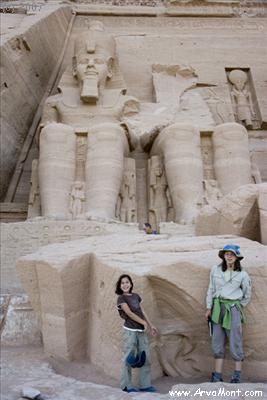 An earthquake damaged the temples many years ago - this is a
fallen head
An earthquake damaged the temples many years ago - this is a
fallen head
From Abu Simbel we flew back to
Cairo and from there on to Istanbul.
|  Around
the World With the ArvaMonts
Around
the World With the ArvaMonts









































































